Apache vs Houma Community Comparison
COMPARE
Apache
Houma
Social Comparison
Social Comparison
Apache
Houma
1,423
SOCIAL INDEX
11.8/ 100
SOCIAL RATING
309th/ 347
SOCIAL RANK
384
SOCIAL INDEX
1.4/ 100
SOCIAL RATING
346th/ 347
SOCIAL RANK
Houma Integration in Apache Communities
The statistical analysis conducted on geographies consisting of 30,660,831 people shows a strong positive correlation between the proportion of Houma within Apache communities in the United States with a correlation coefficient (R) of 0.705. On average, for every 1% (one percent) increase in Apache within a typical geography, there is an increase of 0.221% in Houma. To illustrate, in a geography comprising of 100,000 individuals, a rise of 1,000 Apache corresponds to an increase of 220.7 Houma.
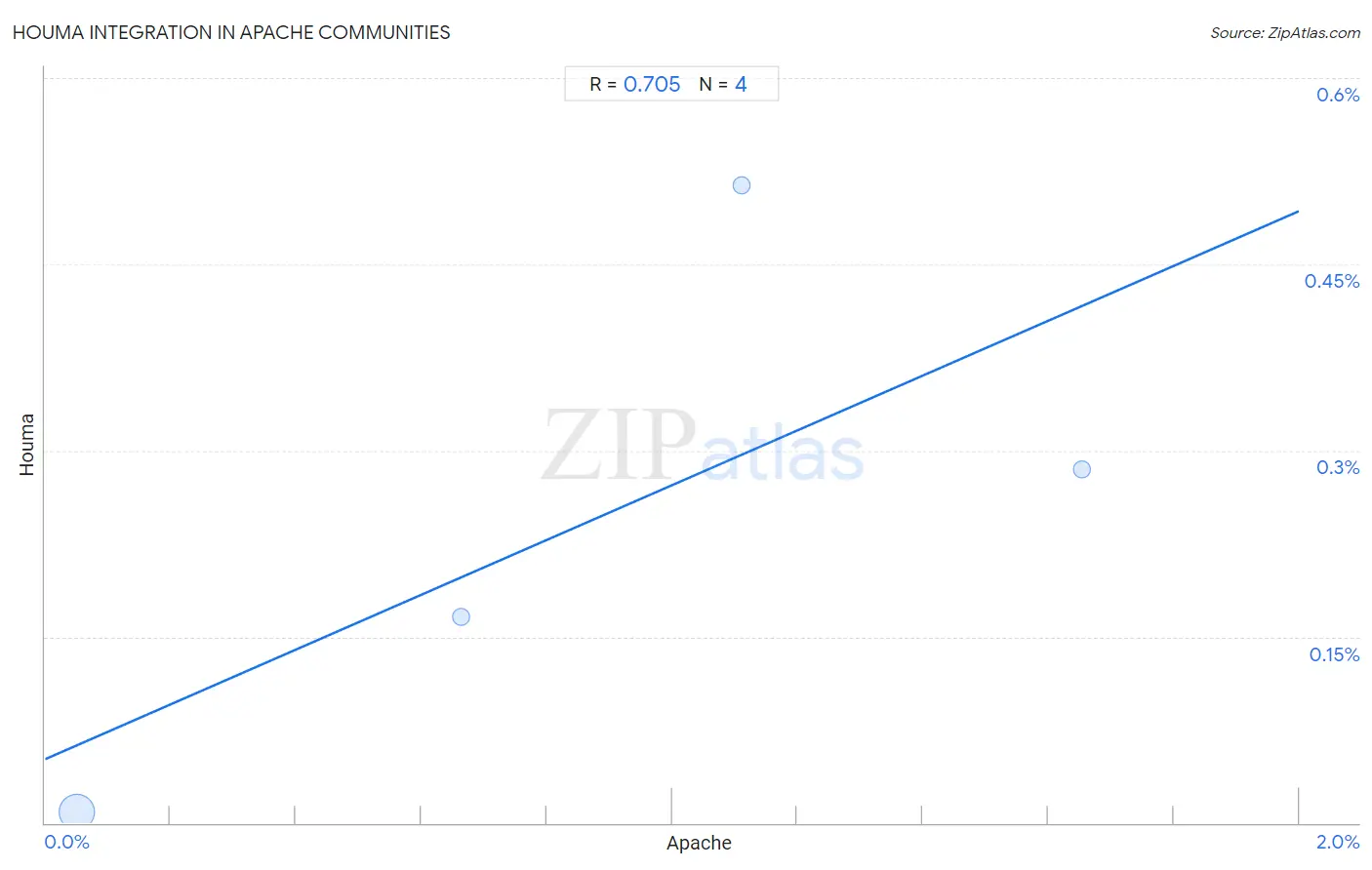
Apache vs Houma Income
When considering income, the most significant differences between Apache and Houma communities in the United States are seen in wage/income gap (24.5% compared to 38.7%, a difference of 57.4%), householder income over 65 years ($54,668 compared to $44,822, a difference of 22.0%), and median female earnings ($34,895 compared to $30,343, a difference of 15.0%). Conversely, both communities are more comparable in terms of median earnings ($40,388 compared to $38,949, a difference of 3.7%), householder income ages 25 - 44 years ($80,260 compared to $77,044, a difference of 4.2%), and per capita income ($34,886 compared to $32,996, a difference of 5.7%).

| Income Metric | Apache | Houma |
| Per Capita Income | Tragic $34,886 | Tragic $32,996 |
| Median Family Income | Tragic $84,451 | Tragic $76,188 |
| Median Household Income | Tragic $70,927 | Tragic $62,575 |
| Median Earnings | Tragic $40,388 | Tragic $38,949 |
| Median Male Earnings | Tragic $46,429 | Tragic $50,547 |
| Median Female Earnings | Tragic $34,895 | Tragic $30,343 |
| Householder Age | Under 25 years | Tragic $49,395 | Tragic $44,356 |
| Householder Age | 25 - 44 years | Tragic $80,260 | Tragic $77,044 |
| Householder Age | 45 - 64 years | Tragic $82,184 | Tragic $72,093 |
| Householder Age | Over 65 years | Tragic $54,668 | Tragic $44,822 |
| Wage/Income Gap | Exceptional 24.5% | Tragic 38.7% |
Apache vs Houma Poverty
When considering poverty, the most significant differences between Apache and Houma communities in the United States are seen in married-couple family poverty (9.0% compared to 6.4%, a difference of 40.4%), single female poverty (27.7% compared to 33.8%, a difference of 22.0%), and single mother poverty (36.6% compared to 43.5%, a difference of 18.9%). Conversely, both communities are more comparable in terms of poverty (18.4% compared to 18.4%, a difference of 0.0%), female poverty among 18-24 year olds (26.3% compared to 26.2%, a difference of 0.53%), and family poverty (14.7% compared to 14.6%, a difference of 0.85%).
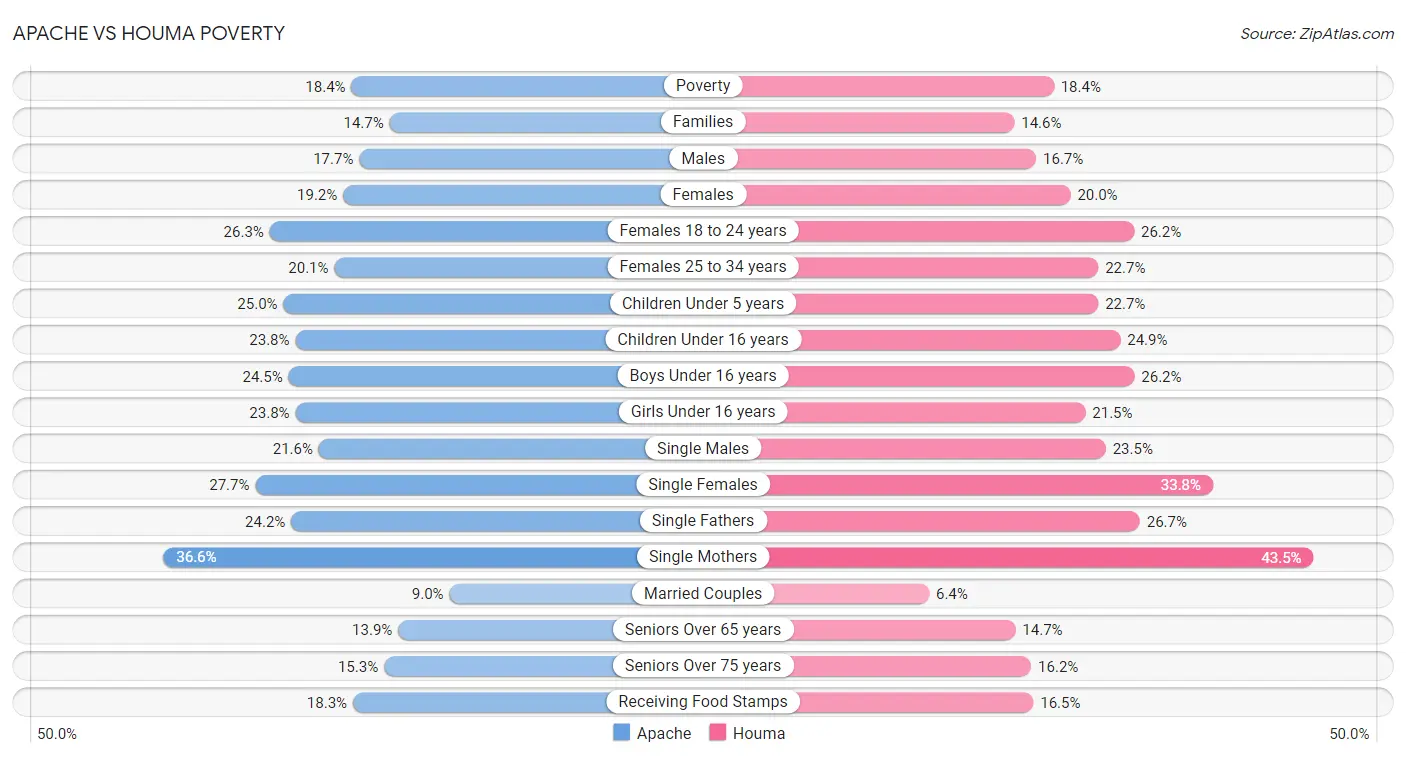
| Poverty Metric | Apache | Houma |
| Poverty | Tragic 18.4% | Tragic 18.4% |
| Families | Tragic 14.7% | Tragic 14.6% |
| Males | Tragic 17.7% | Tragic 16.7% |
| Females | Tragic 19.2% | Tragic 20.0% |
| Females 18 to 24 years | Tragic 26.3% | Tragic 26.2% |
| Females 25 to 34 years | Tragic 20.1% | Tragic 22.7% |
| Children Under 5 years | Tragic 25.0% | Tragic 22.7% |
| Children Under 16 years | Tragic 23.8% | Tragic 24.9% |
| Boys Under 16 years | Tragic 24.5% | Tragic 26.2% |
| Girls Under 16 years | Tragic 23.8% | Tragic 21.5% |
| Single Males | Tragic 21.6% | Tragic 23.5% |
| Single Females | Tragic 27.7% | Tragic 33.8% |
| Single Fathers | Tragic 24.2% | Tragic 26.7% |
| Single Mothers | Tragic 36.6% | Tragic 43.5% |
| Married Couples | Tragic 9.0% | Tragic 6.4% |
| Seniors Over 65 years | Tragic 13.9% | Tragic 14.7% |
| Seniors Over 75 years | Tragic 15.3% | Tragic 16.2% |
| Receiving Food Stamps | Tragic 18.3% | Tragic 16.5% |
Apache vs Houma Unemployment
When considering unemployment, the most significant differences between Apache and Houma communities in the United States are seen in unemployment among women with children under 6 years (12.3% compared to 9.4%, a difference of 31.0%), unemployment among ages 45 to 54 years (7.0% compared to 5.6%, a difference of 24.7%), and unemployment among ages 60 to 64 years (6.0% compared to 4.9%, a difference of 21.5%). Conversely, both communities are more comparable in terms of unemployment among ages 30 to 34 years (7.3% compared to 7.2%, a difference of 2.6%), unemployment among youth under 25 years (13.5% compared to 13.8%, a difference of 2.8%), and female unemployment (6.6% compared to 6.4%, a difference of 3.0%).
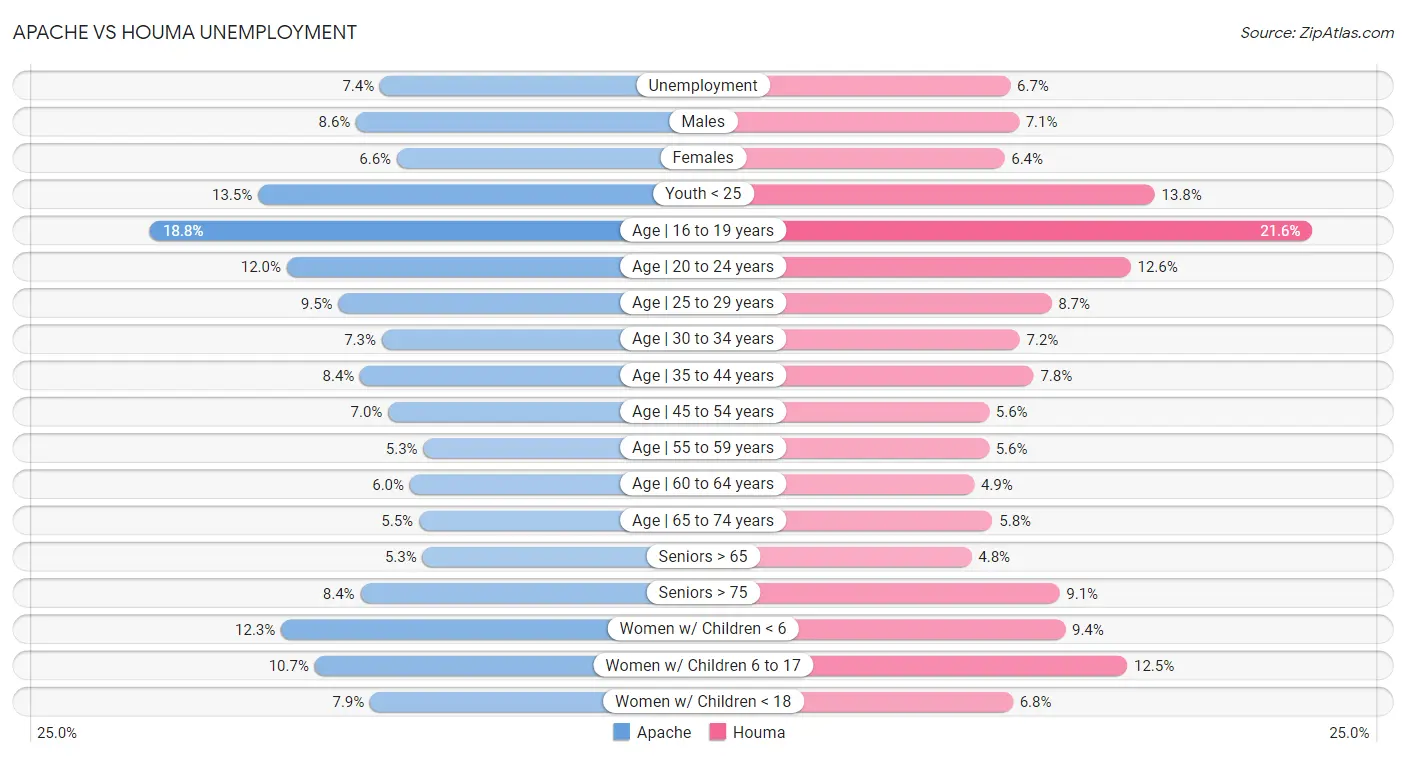
| Unemployment Metric | Apache | Houma |
| Unemployment | Tragic 7.4% | Tragic 6.7% |
| Males | Tragic 8.6% | Tragic 7.1% |
| Females | Tragic 6.6% | Tragic 6.4% |
| Youth < 25 | Tragic 13.5% | Tragic 13.8% |
| Age | 16 to 19 years | Tragic 18.8% | Tragic 21.6% |
| Age | 20 to 24 years | Tragic 12.0% | Tragic 12.6% |
| Age | 25 to 29 years | Tragic 9.5% | Tragic 8.7% |
| Age | 30 to 34 years | Tragic 7.3% | Tragic 7.2% |
| Age | 35 to 44 years | Tragic 8.4% | Tragic 7.8% |
| Age | 45 to 54 years | Tragic 7.0% | Tragic 5.6% |
| Age | 55 to 59 years | Tragic 5.3% | Tragic 5.6% |
| Age | 60 to 64 years | Tragic 6.0% | Fair 4.9% |
| Age | 65 to 74 years | Tragic 5.5% | Tragic 5.8% |
| Seniors > 65 | Tragic 5.3% | Exceptional 4.8% |
| Seniors > 75 | Exceptional 8.4% | Tragic 9.1% |
| Women w/ Children < 6 | Tragic 12.3% | Tragic 9.4% |
| Women w/ Children 6 to 17 | Tragic 10.7% | Tragic 12.5% |
| Women w/ Children < 18 | Tragic 7.9% | Tragic 6.8% |
Apache vs Houma Labor Participation
When considering labor participation, the most significant differences between Apache and Houma communities in the United States are seen in in labor force | age 45-54 (77.1% compared to 74.1%, a difference of 4.1%), in labor force | age 25-29 (79.2% compared to 81.2%, a difference of 2.5%), and in labor force | age 20-24 (72.0% compared to 73.7%, a difference of 2.3%). Conversely, both communities are more comparable in terms of in labor force | age 16-19 (35.6% compared to 35.6%, a difference of 0.010%), in labor force | age 30-34 (79.0% compared to 79.9%, a difference of 1.1%), and in labor force | age 20-64 (73.7% compared to 72.7%, a difference of 1.3%).

| Labor Participation Metric | Apache | Houma |
| In Labor Force | Age > 16 | Tragic 60.7% | Tragic 59.5% |
| In Labor Force | Age 20-64 | Tragic 73.7% | Tragic 72.7% |
| In Labor Force | Age 16-19 | Poor 35.6% | Poor 35.6% |
| In Labor Force | Age 20-24 | Tragic 72.0% | Tragic 73.7% |
| In Labor Force | Age 25-29 | Tragic 79.2% | Tragic 81.2% |
| In Labor Force | Age 30-34 | Tragic 79.0% | Tragic 79.9% |
| In Labor Force | Age 35-44 | Tragic 77.9% | Tragic 79.5% |
| In Labor Force | Age 45-54 | Tragic 77.1% | Tragic 74.1% |
Apache vs Houma Family Structure
When considering family structure, the most significant differences between Apache and Houma communities in the United States are seen in births to unmarried women (39.9% compared to 46.6%, a difference of 16.8%), average family size (3.46 compared to 3.18, a difference of 9.0%), and currently married (43.2% compared to 45.5%, a difference of 5.3%). Conversely, both communities are more comparable in terms of single mother households (7.9% compared to 7.9%, a difference of 0.58%), family households (66.5% compared to 65.7%, a difference of 1.3%), and married-couple households (43.9% compared to 44.6%, a difference of 1.6%).

| Family Structure Metric | Apache | Houma |
| Family Households | Exceptional 66.5% | Exceptional 65.7% |
| Family Households with Children | Exceptional 29.0% | Exceptional 28.5% |
| Married-couple Households | Tragic 43.9% | Tragic 44.6% |
| Average Family Size | Exceptional 3.46 | Tragic 3.18 |
| Single Father Households | Tragic 2.8% | Tragic 2.9% |
| Single Mother Households | Tragic 7.9% | Tragic 7.9% |
| Currently Married | Tragic 43.2% | Tragic 45.5% |
| Divorced or Separated | Tragic 12.9% | Tragic 13.6% |
| Births to Unmarried Women | Tragic 39.9% | Tragic 46.6% |
Apache vs Houma Vehicle Availability
When considering vehicle availability, the most significant differences between Apache and Houma communities in the United States are seen in 4 or more vehicles in household (7.4% compared to 4.9%, a difference of 50.0%), 3 or more vehicles in household (21.2% compared to 16.1%, a difference of 31.7%), and no vehicles in household (11.0% compared to 11.5%, a difference of 4.0%). Conversely, both communities are more comparable in terms of 1 or more vehicles in household (89.1% compared to 88.6%, a difference of 0.53%), 2 or more vehicles in household (55.1% compared to 54.4%, a difference of 1.1%), and no vehicles in household (11.0% compared to 11.5%, a difference of 4.0%).

| Vehicle Availability Metric | Apache | Houma |
| No Vehicles Available | Poor 11.0% | Tragic 11.5% |
| 1+ Vehicles Available | Poor 89.1% | Tragic 88.6% |
| 2+ Vehicles Available | Fair 55.1% | Poor 54.4% |
| 3+ Vehicles Available | Exceptional 21.2% | Tragic 16.1% |
| 4+ Vehicles Available | Exceptional 7.4% | Tragic 4.9% |
Apache vs Houma Education Level
When considering education level, the most significant differences between Apache and Houma communities in the United States are seen in doctorate degree (1.5% compared to 0.96%, a difference of 61.5%), professional degree (3.5% compared to 2.2%, a difference of 59.9%), and master's degree (11.0% compared to 7.9%, a difference of 38.6%). Conversely, both communities are more comparable in terms of 3rd grade (97.8% compared to 97.1%, a difference of 0.70%), 2nd grade (97.9% compared to 97.2%, a difference of 0.77%), and 5th grade (97.4% compared to 96.6%, a difference of 0.77%).
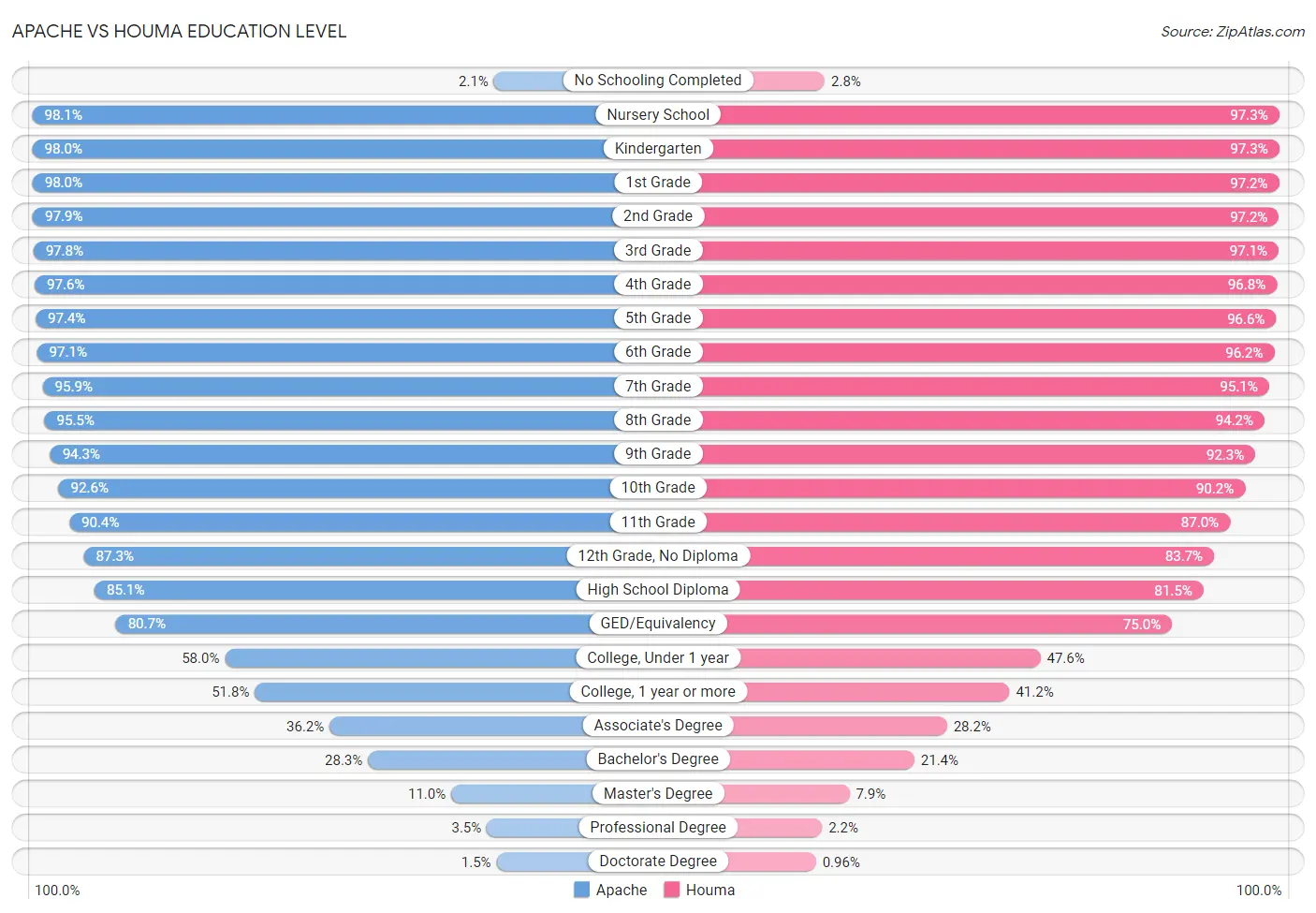
| Education Level Metric | Apache | Houma |
| No Schooling Completed | Average 2.1% | Tragic 2.8% |
| Nursery School | Good 98.1% | Tragic 97.3% |
| Kindergarten | Good 98.0% | Tragic 97.3% |
| 1st Grade | Good 98.0% | Tragic 97.2% |
| 2nd Grade | Good 97.9% | Tragic 97.2% |
| 3rd Grade | Good 97.8% | Tragic 97.1% |
| 4th Grade | Good 97.6% | Tragic 96.8% |
| 5th Grade | Average 97.4% | Tragic 96.6% |
| 6th Grade | Average 97.1% | Tragic 96.2% |
| 7th Grade | Fair 95.9% | Tragic 95.1% |
| 8th Grade | Poor 95.5% | Tragic 94.2% |
| 9th Grade | Tragic 94.3% | Tragic 92.3% |
| 10th Grade | Tragic 92.6% | Tragic 90.2% |
| 11th Grade | Tragic 90.4% | Tragic 87.0% |
| 12th Grade, No Diploma | Tragic 87.3% | Tragic 83.7% |
| High School Diploma | Tragic 85.1% | Tragic 81.5% |
| GED/Equivalency | Tragic 80.7% | Tragic 75.0% |
| College, Under 1 year | Tragic 58.0% | Tragic 47.6% |
| College, 1 year or more | Tragic 51.8% | Tragic 41.2% |
| Associate's Degree | Tragic 36.2% | Tragic 28.2% |
| Bachelor's Degree | Tragic 28.3% | Tragic 21.4% |
| Master's Degree | Tragic 11.0% | Tragic 7.9% |
| Professional Degree | Tragic 3.5% | Tragic 2.2% |
| Doctorate Degree | Tragic 1.5% | Tragic 0.96% |
Apache vs Houma Disability
When considering disability, the most significant differences between Apache and Houma communities in the United States are seen in disability age 5 to 17 (6.4% compared to 9.1%, a difference of 42.0%), ambulatory disability (7.4% compared to 9.3%, a difference of 26.1%), and disability age 35 to 64 (14.9% compared to 18.7%, a difference of 25.2%). Conversely, both communities are more comparable in terms of cognitive disability (18.6% compared to 19.3%, a difference of 3.4%), hearing disability (4.1% compared to 4.2%, a difference of 3.5%), and disability age over 75 (53.6% compared to 56.2%, a difference of 4.8%).
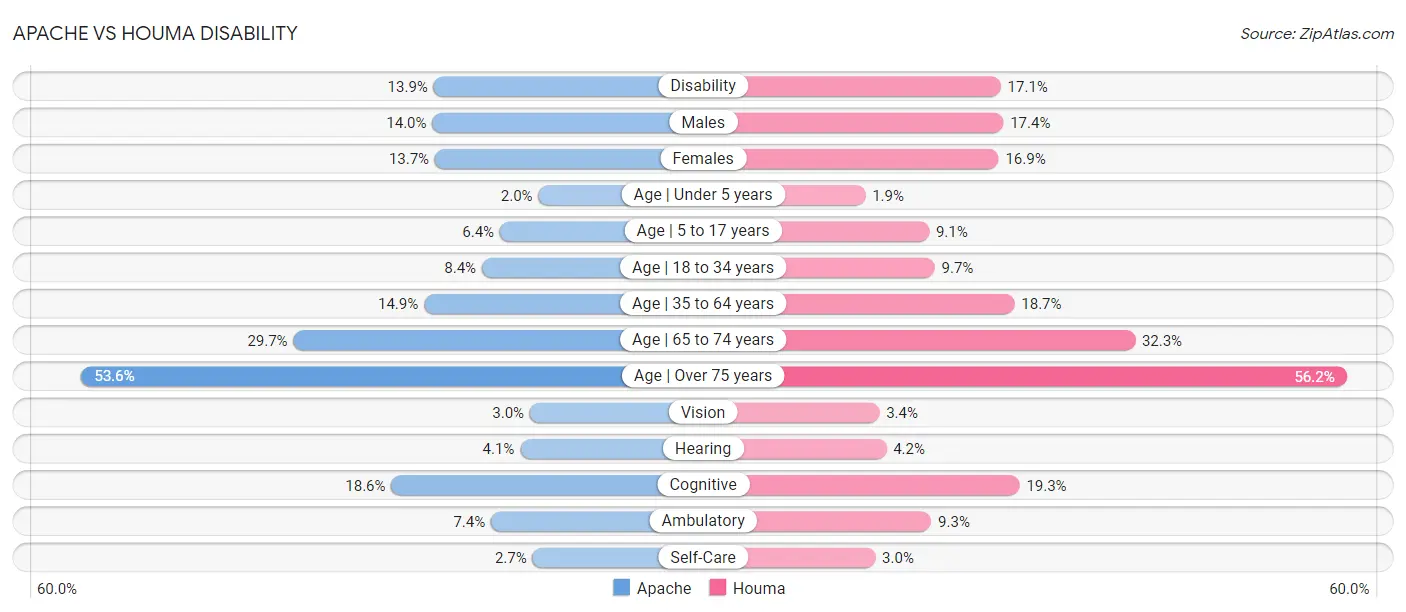
| Disability Metric | Apache | Houma |
| Disability | Tragic 13.9% | Tragic 17.1% |
| Males | Tragic 14.0% | Tragic 17.4% |
| Females | Tragic 13.7% | Tragic 16.9% |
| Age | Under 5 years | Tragic 2.0% | Tragic 1.9% |
| Age | 5 to 17 years | Tragic 6.4% | Tragic 9.1% |
| Age | 18 to 34 years | Tragic 8.4% | Tragic 9.7% |
| Age | 35 to 64 years | Tragic 14.9% | Tragic 18.7% |
| Age | 65 to 74 years | Tragic 29.7% | Tragic 32.3% |
| Age | Over 75 years | Tragic 53.6% | Tragic 56.2% |
| Vision | Tragic 3.0% | Tragic 3.4% |
| Hearing | Tragic 4.1% | Tragic 4.2% |
| Cognitive | Tragic 18.6% | Tragic 19.3% |
| Ambulatory | Tragic 7.4% | Tragic 9.3% |
| Self-Care | Tragic 2.7% | Tragic 3.0% |